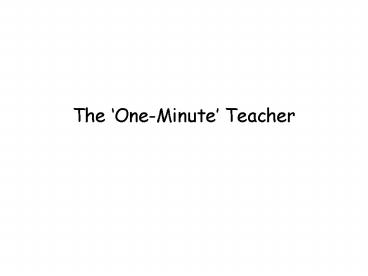The OneMinute Teacher - PowerPoint PPT Presentation
1 / 14
Title:
The OneMinute Teacher
Description:
Novices are more likely to make a correct diagnosis if they make an early ... The seeker for knowledge will profit from guide-ropes and tug-ropes.' Evans, 1968 ... – PowerPoint PPT presentation
Number of Views:53
Avg rating:3.0/5.0
Title: The OneMinute Teacher
1
The One-Minute Teacher
2
(No Transcript)
3
- Communication is the key to effective clinical
teaching - Questioning
- Explaining
- Feedback
- Clinical reasoning is mostly based on
- Pattern recognition
- Novices are more likely to make a correct
diagnosis if they make an early commitment - But remain reflective
- Modelling professional thinking is helpful
4
Questions, questions..
- Whats the point in asking questions?
- The seeker for knowledge will profit from
guide-ropes and tug-ropes. - Evans, 1968
5
Questions, questions help to
- Arouse interest
- Find stuff out
- Activate prior knowledge
- Test knowledge understanding
- Motivate
- Promote understanding
- Explaining paraphrasing compare contrast
summarising - Provide new insights
- Model professional thinking
- Diagnose strengths and weaknesses
6
Cognitive/knowledge levels
- A simple classification
- Recall - What? When? Which?
- Comprehension - Why? How?
- Problem solving - What if?
7
- Questions aimed at different cognitive levels
- Recall
- Whats the name of that bone?
- What drug do we use for this condition?
- Comprehension
- What dose of this drug would you prescribe for an
18 month old child of average weight and why? - If a patient with acute renal failure has a daily
output of 300 ml of urine, about how much fluid
should he receive? - Problem solving
- What if this patient did not respond to that
treatment regime? - How will you know if that was a good decision?
8
Questions, questions..Some rules of thumb
- Restrict closed questions to clarification
- Ask open questions in all other circumstances,
particularly probing questions - What if..? What are the options? How would you
know if..? Why do you say that? Why might we..?
Under what circumstances..? - Allow adequate thinking time
- Use counter questions
- Follow a poor answer with another question
9
Discussion
Presentation
Clarification
Hypothetical 10 minute teaching encounter -
typical
10
Discussion
Presentation
Clarification
Hypothetical 10 minute teaching encounter - ideal
11
- Without feedback..
- Mistakes remain uncorrected bad habits can
develop - Learners may drop desirable behaviour
- Learners may make inaccurate assumptions
12
- Novices arent always equipped to give themselves
feedback - Self assessment sucks (Geoff Norman)
- Feedback
- Modifies behaviour
- Increases motivation
- Encourages reflection
- Increases self-efficacy
13
The bottom lineFeedback is the lifeblood of
learningand it must be kept flowing
(Rowntree)
14
The one minute teacherMicroskills for clinical
teaching
- Get a commitment - What do you think is going on?
- Probe for supporting evidence - Why do you think
that? - Teach general rules - When this happens, do
this.. - Reinforce what was right - Specifically you did a
good job of... - Correct mistakes - Next time this happens, try
this - Conclusion (closing the loop) - Action plan































